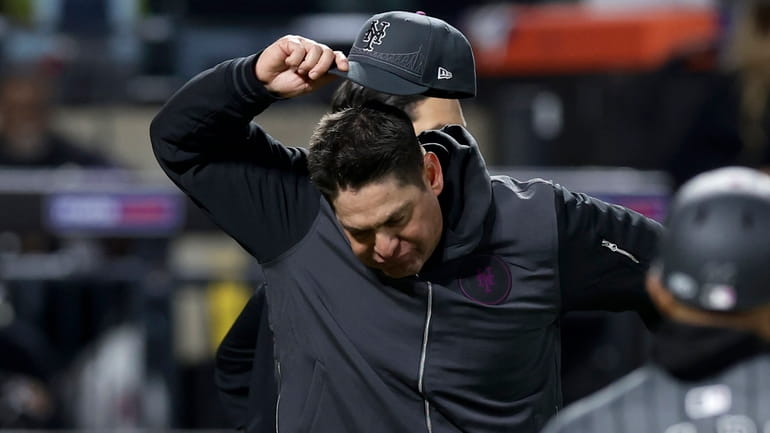In the wake of Mets' perplexing loss, MLB has some explaining to do

Manager Carlos Mendoza #64 of the Mets reacts after losing against the Chicago Cubs at Citi Field on Wednesday, May 1, 2024. Credit: Jim McIsaac
Carlos Mendoza didn’t mince words. He didn’t second-guess, and he didn’t leave room for argument.
“I have to see what (Major League Baseball) says because clearly, they got it wrong,” he said after the Mets dramatic 1-0 loss to the Cubs at Citi Field Wednesday night.
The situation was this: With runners on second and third and one out in the ninth, Jeff McNeil flied out to left – chasing Pete Alonso home with the potential tying run. Alonso tagged up and dove headfirst as Miguel Amaya collected the relay throw from Nick Madrigal. One issue, though – Amaya’s foot was on the plate before he had possession of the ball, and according to Mendoza, that’s a blocking violation, meaning Alonso should’ve been ruled safe.
Instead, Alonso's hand popped up as he slid, allowing Amaya to get down the tag, and no blocking was called.
“They sent out a memo in spring training of what’s legal and what’s illegal and clearly, on that email, that memo that we got – catchers are not allowed to have their foot in front of the plate, on top of the plate and not straddle without possession of the baseball,” Mendoza said. “It was very clear had his left foot on top of the plate without the baseball.”
In those words, Mendoza displayed a certainty that has seemingly evaded much of baseball – so much so that even Madrigal wondered if they had violated the rule as he watched the replays on Citi’s giant screen.
“I hadn’t even seen that rule come into play, with the blocking in the plate,” he said. “And then when he announced it, I thought he said he was blocking the plate so I kind of freaked out for a second.”
For what it’s worth, MLB’s replay room said Amaya wasn’t called for blocking because the act of stepping on the plate was “in reaction to the trajectory of the incoming throw,” which is allowed, according to the "Collisions at Home Plate" rule on MLB's website.
But Mendoza didn’t believe that was an accurate representation of the updated memo they received, and neither did Omar Narvaez, who said that once he saw the replay, he thought for sure the call was going to go the Mets’ way.
The thing is, there’s no way to tell who’s right in this scenario. A small lane was, indeed, open for Alonso to slide, but Amaya’s foot was also there blocking the plate a good long time before the throw came in.
And that’s a big, big problem.
MLB has introduced a slew of new rules in recent years, and though many have done their intended job – namely, cutting down game times and creating more offense – they’ve also introduced a lot of confusion. There’s the blocking rule, yes, but also some borderline balk calls that have had pitchers wondering what’s legal and what’s not. And who can forget the obstruction call on Francisco Lindor during spring training – you know, the one that had everyone going, ‘wait, that’s illegal now?’
And look, baseball can do whatever it wants – The Show is, after all, their show. Sure, the Player’s Association puts some checks in place, but broadly speaking, commissioner Rob Manfred has gotten his way (Want proof? Look at the sped up pitch clock that seems likely to have caused havoc on some of the game’s best arms).
But there’s also a responsibility there: If we’re going to maintain a spirit of fairness, there has to be a universal understanding of how these rules are applied. That memo Mendoza was talking about should be public. And players should know exactly what’s allowed and what’s not.
That doesn't remotely seem to be the case. Asked if he thought he was safe, the best Alonso could offer was a verbal shrug.
“It’s really not up for me to decide,” he said. “I saw a smidge of the plate open. I mean, his foot was on the dish, and I was just trying to stick my hand on where there was some open space on the plate. I was just trying to make a play.”
It’s kind of wild, if you think about it – players whose entire livelihood is dependent on whether or not that can cross that white pentagon are sometimes confused as to what that might legally look like. What happens, then, when a rule like this isn’t affecting a game in May, but rather, one in October?
What’s more, because the call comes from MLB’s replay headquarters, the umpires can’t provide any explanation to reporters that might be conveyed back to the public. All that was available Wednesday was a few prepared paragraphs, emailed out a little after the game ended. No follow-up questions. No extra information.
That lack of accountability can only hurt the sport.
“I don’t know” why the rule is so confusing, Mendoza said. “I wish I knew that. It’s a different interpretation. It’s not consistent.”
Reactions from players Wednesday night bear that out. And that’s simply unacceptable.
